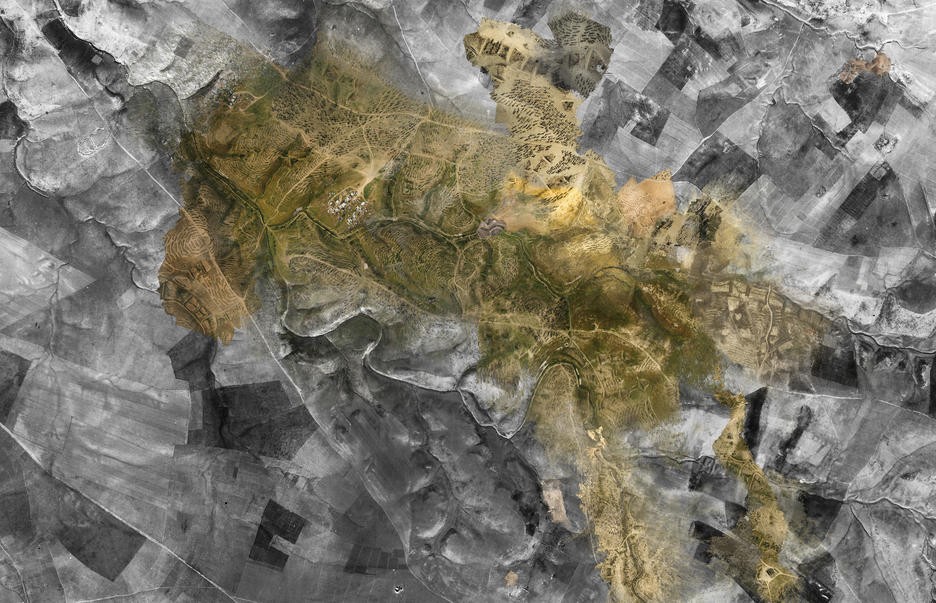Ground Truth: Testimonies of Destruction and Return in Al-Araqib

On Palestinian Bedouin villages in the Naqab (Negev)
The Center for Palestine Studies, in partnership with the NGO Zochrot, and Forensic Architecture, will host an exhibition (October 10-November 9) and symposium titled From Res Nullius to Terra Nullius: Revisiting Indigenous Histories, Legal Systems and Land Rights in the Naqab (October 11), focused on two counter investigations concerning the Palestinian-Bedouin villages of Al-Araqib and Umm al-Hiran in the Naqab/Negev region of southern Israel.
A joint project of Al-Araqib Popular Committee, Zochrot and Forensic Architecture (Goldsmiths University, UK).
Curator: Debby Farber, Zochrot
Principal Investigator: Prof. Eyal Weizman (Forensic Architecture), Project coordinator: Ariel Caine (Forensic Architecture)
Al-Araqib Committee: Nūri al-Uqbi, Sheikh Sayah al-Tūri, Aziz al-Tūri, Ahmad Abu Mdigam, Salim Abu Mad'im, Awad Abu- Freih, Sabah al-Tūri, Mariam Abu Mdigam
Co-sponsors: Studio-X Amman at Columbia GSAPP and Columbia Global Centers | Amman, The Heyman Center for Humanities, and the Department of Religion.
The exhibition presents an ongoing investigation undertaken by the inhabitants of the Palestinian-Bedouin village of Al-Araqib, Forensic Architecture, Zochrot, which aims to collect, document and produce historical, legal, spatial and material evidence that map historical remains of Al-Araqib villagers’ sedentary settlement on their land – a moment before they disappear.
Destroyed and rebuilt over 130 times in the past 70 years, Al-Araqib has become emblematic of the broader struggle of so-called “unrecognized villages” outlawed by the Israeli government on the northern threshold of the Naqab/Negev desert. Since the Nakba – the uprooting of about 750,000 Palestinians in 1948 – Israel has promulgated a system of laws enabling it to easily dispossess the Bedouins, adopting a labyrinthine legal logic that prevents most of them from holding on to their ancestral lands. This process has relied on various appropriation laws that all ignore the area’s indigenous past. In particular, they ignore the property laws and land tenure system that have governed the area for generations, in agreement with the country’s previous rules. The ongoing erasure of these villages from maps, satellite images and historical records, so-called “land reclamation” works, and the intensive afforestation led by Israel are all designed to prevent Bedouin families from returning to their lands on the day when their struggle for recognition of land rights prevails.
Against these ongoing acts of dispossession, destruction and erasure, the project exposes evidence which attests to patterns of Al-Araqib residents’ cultivation and settlement of the desert threshold lands for centuries, thereby restoring the traces to the representational and geographic space from which they have been erased.
The second investigation focuses on the killings of Yaqub Musa Abu al-Qi’an, resident of the village Umm al-Hiran, and of the Israeli police officer Erez Levi on October 18, 2017, during a police raid aimed at demolishing the village to make space for a new Jewish settlement. Shortly after, the Israeli government and police claimed that Levi’s death was the result of a ‘terror attack’ by al-Qi’an, and suggested that he had links to the terrorist group ISIS.
Forensic Architecture’s investigation of the events, in collaboration with the photographic collective ActiveStills, exposes this false narrative, and establishes the veracity of local resident and activist claims that Abu al-Qi’an lost control of his vehicle and ran over Levi only after being shot by Israeli policemen, and that he was subsequently left to bleed out and die. The investigation uncovers the few seconds in which the incident unfolded, and the months-long process of investigation and exposure, telling these stories against the long-term historical context of the region.
Ground Truth is a term coined by NASA to refer to the simultaneous measurements of data on the ground and from an airplane or satellite in order to validate those measurements. Similarly, the evidence produced and displayed in this exhibition is the outcome of the calibration of archival repositories and spatial information systems with contemporary images, videos, documents and materials – summoned and cross-referenced – allowing the articulation of complex public claims through the uncovering of political violence undertaken by the state. The notion of Ground Truth thus highlights the ever-present gap between reality and its representation, and the importance of such anchoring in testing different possible realities.
Debby Farber, Curator Zochrot NGO
Debby Farber is the curator of Zochrot NGO ("Remembering" in Hebrew), an Israeli organization working to promote acknowledgement and accountability for the ongoing injustices of the Nakba, the Palestinian catastrophe of 1948. From 2012 to 2014 she served as the Civil Transitional Justice program director in Zochrot where she established the first Unofficial Truth Commission in Israel for the events of 1948 in the Negev. Debby is a former AHDA fellow of the Institute for the Study for Human Rights at Columbia University and is currently also a PhD Candidate in the Politics and Government Department in Ben Gurion University where she explores the linkages between Visual Culture, History and Political Geography within the visual historiography of Israel/Palestine.